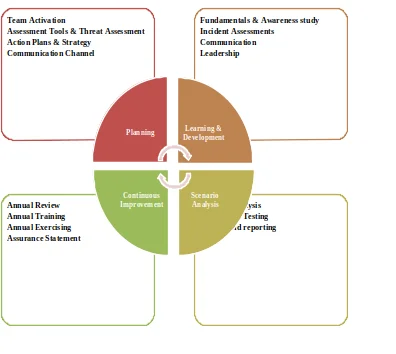

Bibhas Biswas, IOCL, Anirban Das Gupta, IOCL
bibhasb@indianoil.in, adasgupta@indianoil.in
Mr. Dasgupta started his career in Magazine Journalism and worked as Assistant Professor of Communication Studies under North Bengal University before joining IndianOil in 2011. An avid reader and a passionate photographer, Mr Dasgupta brings a fresh perspective into communication studies

Introduction
Present is the era of social networks and open media. Any news or message going into the media or any social site today reaches directly to millions and attracts lots of reactions from society. From the organization’s point of view, we need to be extra cautious in case of any mishap and develop a specific strategy for effective media and boundary management practices to build a positive image.
From the P&NG industry perspective, pilferage/ oil spills or any accident and health concerns such as contamination are some threats that could affect our organization, leading to a disastrous impact on business profitability and even sustainability. The occurrence of any of these incidents can lead to Crisis. In general terms, any crisis can be defined as an event/situation that results in a total or partial disruption of key business and operational processes due to harm to people or damage to property, equipment, or the environment and negatively influences stakeholders’ perception.
Crises can occur at any time, and hence the challenge of identifying, preventing, and managing crisis events has become a critical concern for many organizations. This, as a consequence of the direct impact and the stakeholders’ negative responses, may dramatically impact profitability, reputation, and hence the long-term operational sustainability potential of the concerned organization. The following are the key players in this aspect – Public, Local and International NGOs, Local, National and International Tri-media, Social Media and the Concerned AGENCY.
Crisis and Media
It is a matter of fact that the impact of media is now global. Even a small incident in a distant locality can make National or International Headline. As the saying goes: a story anywhere is a story everywhere. In a propagandistic society, Media barons control news agenda. In addition to this, one cannot deny the impact of the various pressure groups. Media actually loves crisis. As, well-cooked up crisis stories increases readership as well as TRP. More so, both electronic and print media has a structure design to handle and report crisis by means of fast communications links, staff training and managerial structures.
Preparing for the Worst
Petroleum & Gas companies in India operates a network of cross country crude oil, petroleum product and gas pipelines. The companies are also framing a huge investment plan to add various long-distance pipelines for petroleum products over the next few years for transporting fuel from refineries to depots and LPG from import terminals to various bottling plants. The pipelines transport petroleum products from refineries to demand areas and crude oil from import terminals as well as domestic sources to the inland refineries. Seeing this numbers, one can easily understand the
difficulty to monitor this huge network. So, any attempt made for pilferage similar activity can lead to Crisis.
The first step in getting ready to handle this crisis is to acknowledge the fact that it can happen anywhere and at any time. To effectively deal with the same, we should be able to react correctly when such situations arise. Being prepared for any untoward incident is about building the capacity of employees to tackle serious incidents by equipping them with the knowledge on how to make serious but important decisions that will safely steer the organization through the storm.
Questions we may face during the Incident
Who will disseminate the information?
What will be disseminated?
When will it be disseminated?
Where are the areas that are affected by the disseminated information?
How will the information be disseminated?
Role of HR towards Organizational Sustainability
“HR has never been associated with decision making, operations or business data. It has always had this bumper sticker of being too ‘soft’, more of a shoulder to cry on than a hand that walks you through troubles.”
As blunt as it may sound, that’s exactly the perception of HR in other more strategic and business-critical parts of the organization. HR has been fighting a consistent battle in justifying its position as a strategic business partner in organizations. However, in troubled times, HR is doing what HR does best – “managing people”. It is these tough times where HR can prove its mettle and showcase its worth as an equally powerful part of the organization. The HR function has the key role to play not only in protecting the welfare and safety of affected employees but also in supporting organizational sustainability. From communicating employees about strategy formation & crisis management plan, to addressing key issues afterwards mitigation and business continuation phase, HR has to play a crucial role.
It is important to communicate with employees before, during, and after a crisis in an effort to stop rumors, give good information, and let people know what’s going on. Informing the stakeholders in advance should be the company’s primary objective. The program should include training and mechanisms to mitigate the myriad of potential problems the company and its employees might face. Employers should ask themselves, “What could go wrong, and how would we deal with that?”
Awareness of organization’s boundary management program should be incorporated into the corporate culture. Address the program during orientation, and consider having every employee watch a training video or complete a training module on it. Senior Management may need additional training on how to work with their teams during and after any such incidents, and certain segments of our workforce might be given specialized training.
Develop a preparedness plan that fully integrates the Human Capital
The HR leaders should work collaboratively with other key organizational functions, identifying the types of emergencies that the company may face. Once threats have been identified, a needs assessment should be conducted to determine resources needed for continuing business operations.
With potential threats and resources needed in mind, the following plans should be defined:
Emergency Response Plan.
Crisis Communications Plan, describing how to efficiently communicate with employees, customers, the media and stakeholders.
Business Continuity Plan, listing strategies to overcome the disruption of business.

Establish a Boundary Management Team
The team will be responsible for formulating the policies & strategies that will be followed during the occurrence of any untoward incident; they must consider all options and come up with
contingency plans. It should be composed of people from all cadres, including the head of departments, technical experts, line managers and HR representatives. The experts in this field recommend the roles of the team as:
Team Leader/ Technical Manager: Coordinates the activities.
Media Advisors/ Corporate Communications: Conveys well vetted information.
HR Personnel: Works to resolve the human issues & developing individuals.
HSE Manager: Works to resolve issues related to
Security Manager
Legal counsel etc.
Points to be remembered while dealing with the Situation
Careful planning and preparation
Understand how the spokesperson will address public dissemination?
Don’t panic! Stay focused on the tasks at hand
Work as a team and follow the established Command and control
Communicate! Communication is the key.
Mistakes to Avoid
Avoid “off-the-record comments.”
Avoid rumors, speculation and personal opinions
Avoid jokes, especially when dealing with serious or sensitive topics
Avoid jargons and acronyms that will not be understood.
Avoid repeating the negative portion of a question.
Avoid the term no comment
Brief Media Handling Procedure
Respond to all media calls promptly.
Don’t say anything you are unsure of.
Accept the fact that a reporter’s job is to ask difficult questions.
They will report a story whether you speak to them or not.
Control your voice tone and body language to avoid coming across as defensive, nervous or hostile.
If you don’t understand their question-ask for clarification.
Organize your thoughts and speak in short, simple sentences.
Collaborate with other agencies in issuing statements.
They are not your friends!
Brief Social Media Guidelines
Utilize available social media for informative postings and reliable updates.
Monitor the social media forums, bring it to the attention of the right authority.
Do NOT disseminate ANY information that are not officially approved (not even in closed groups).
DOs
Gather the salient facts as much as you can
Decide your action plan…just issue a statement or to hold a press conference.
Before you meet the press, remember the messages you want to send.
Anticipate questions from the press and rehearse well before meeting them
Arrange a good setting to face the press
Keep your statement clear and concise
Repeat your messages no matter what you are asked.
DON’Ts
Keep silence as it implies you have something to hide & giving up the rights to reply
Don’t hide or try to cover camera
Don’t issue statement late at night
Don’t try to give long and conditional statement
Conclusion
In today’s Information & Knowledge-Economy, Organizations increasingly rely more on knowledge workers to build competitive advantages and safeguard the bottom line, rather than just on technology, machinery and systems. HR leaders have a strategic role and responsibility to ensure and be aware of internal vulnerabilities on the human side and ensure their boundary management plan covers all potential risks and concerns.
Many employers do not have a customized boundary management plan. It’s something people don’t like to think about. Employers with a written plan often have not tailored it to their organization or have not taken additional steps necessary to implement it. Employers with enterprise-wide program that addresses both short- and long-term risks to the company are the best prepared to respond effectively during any untoward incidents.
HR professionals can influence the organizational culture and capabilities to provide adequate preparation, capacity building, and effective management and leadership during and after any untoward incidents. An effective response requires an understanding of the need of the stakeholders as well as management, and knowing how to provide it. The organization more importantly the HR leaders have to maintain two-way relationship with the stakeholders and learn about the status of public opinion by listening. The HR practitioners as well as industry leaders should never forget that each crisis is unique and requires a tailored response.
Posted in HR Business Synergy | No Comments »
Recent Articles
- Networks and Blue Oceans.
- Unleashing Competitive Advantage through Network Effects
- Altruism will elevate the CSR to the next level
- Creating Compassionate Climates through Resonant Leader
- HR Management Issues and Emerging Global Trends
- A life beyond metrics
- HR Practices for New Age Workforce at Hardship Locations
- Replacing the “Oil” in Oil Marketing Companies: An HR Perspective on ICE-to-EV Transition
- Media & Boundary Management Practices and Role of HR
- Green HRM in Post Pandemic World: Opportunities and Threats
- The Perils of Green Washing and Woke Washing
- Green HRM and achieving Organisational Goals with special reference to Cochin International Airport Limited (CIAL)
- Ontology of Green HRM
- Changing Face of Energy man in an increasingly Digitalised world
- Philanthropy No More: Resonating Social contribution with Business Value
- Total Productive Maintenance, a panacea for improving reliability of Plant, Equipment & profitability & optimizing the Human Resources
- HR Business Synergy
